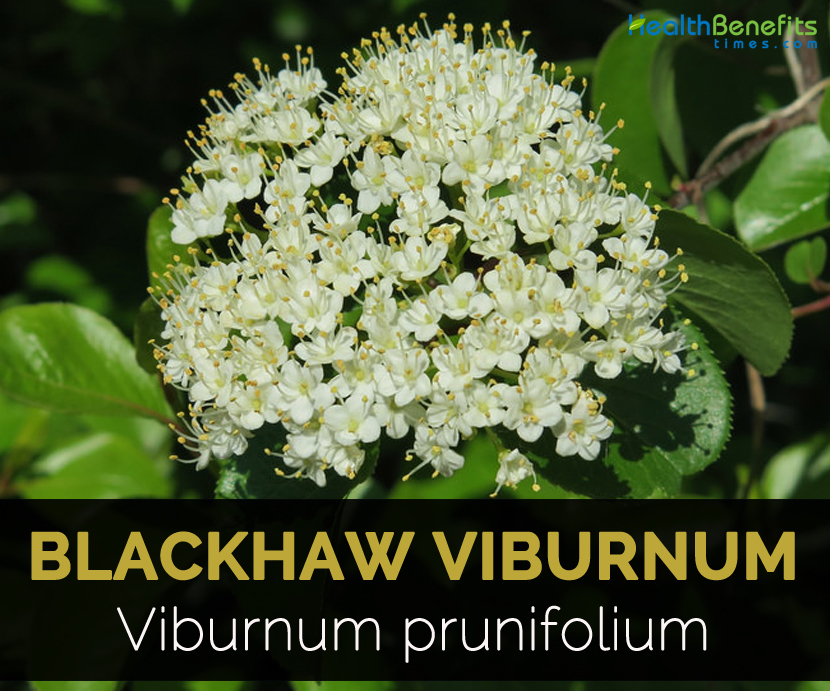| Blackhaw Viburnum Quick Facts | |
|---|---|
| Name: | Blackhaw Viburnum |
| Scientific Name: | Viburnum prunifolium |
| Origin | Native to northeastern North America, from Connecticut west to eastern Kansas, and south to Alabama and Texas |
| Colors | Shiny, black |
| Shapes | Ovoid drupe, 1/3 inches long |
| Taste | Bitter |
| Health benefits | Relax muscles, Treat painful menstruation, Promote circulation, Sedative, Nervine |
Blackhaw is a branched woody shrub which grows 15 feet high. The bark of small branches is gray and slightly rough and old bark is grey and rough having flat topped plates. Leaves are 3 inches long and 1 inch across, glabrous, ovate or ovate to obovate. Petioles are 1 inch long and are reddish. A cymes measure 3 to 5 inches across which develops from leaves axils. Each cyme is much branched and is sessile at the base. Each flower measures ¼ inches across with five white petals and is longer than sepals. There are five long stamens with slender white filaments and yellow anthers and a small pistil at center of the flower which is cream colored at base. Blooming period occurs from mid to late spring. Flowers possess a strong and pleasant fragrance which produced at about the same time of leaves. Flowers are replaced by a fleshy ovoid drupe measuring 1/3 inches long. Drupe becomes blue to black at maturity. Drupes are edible, sweet and somewhat thin fleshed due to their stones.
The active compounds or constituents include salicin, scopoletin, aesculetin, tannin, volatile oil, clibutyl hemimellitate, 1-methy1-2-3 and viburnin.
Flower and Fruit
The flowers are white and richly blossomed, flat and apical cymes. Central florets are campanulate and fertile. Lateral ones are much larger, rotate and infertile. The calyx margin is small and five tipped. The corolla of the fertile florets is 5-petalled and campanulate. There are five stamens, 3 sessile stigmas and a semiinferior ovary. The fruit is a shiny, black and juicy berry.
Leaves, Stem and Root
Black Haw has gray to brown bark and green as well as grooved branches. Leaves are opposite, petiolate, roughly dentate, 3 to 5 lobed, green on both surfaces and softly pubescent beneath.
Health Benefits of Blackhaw
Some health benefits provided by Blackhaw are discussed below:
- Relax muscles
Black haw is considered as important uterine antispasmodics. It is able to relax smooth muscles such as uterus, intestines and airway. It relaxes for striated muscles as they are attached to skeleton like ones in limbs.
- Treat painful menstruation
Dysmenorrhea is the painful menstruation. Uterus contract when the uterine lining sheds as menstruation. Pain can be felt to lower abdomen and lower back, in vulva and radiating down the thighs. Black Haw is effective at lowering uterine contractions and uterine muscle spasms.
- Promote circulation
When the muscles are relaxed, it promotes circulation which promotes the elimination of waste of products not only blood flow in that area of the body. Black haw have relaxing action on uterus which enhance circulation to uterus that allows removal of toxins that aids uterus in healing and overall improvement in uterine health.
- Sedative
Black haw has sedative action that aids body in lowering anxiety, irritability and nervous tension by promoting sense of calm and well-being.
- Nervine
It is helpful for nervous tension.
Traditional uses
- Black Haw is used for dysmenorrhea.
- The decoction made from Black haw is used by Native Americans for treating gynecological conditions such as menstrual cramps, treat menopause effects and aids recovery after childbirth.
- Black haw is used as a folk remedy for morning sickness and menstrual pain.
- It is also used for prevention of miscarriage.
- The plant is used for treating digestive cramps or bile ducts.
- Infusion made from bark is used as a wash for sore tongue.
- Use Blackhaw to provide relief from chronic uterine inflammation and uterine congestion.
- It is helpful for spasmodic dysmenorrhea with excessive flow.
- North American Indians use it to treat dysentery and accommodate haemorrhage of uterus.
- Use the tea internally for treating heavy or painful menstruation, morning sickness, prolapse of uterus, relieve spasms after childbirth and prevent miscarriage.
- It is helpful for colic, cramping pains and convulsive disorders.
- Root bark tincture is used for treating high blood pressure.
- It is used for palpitations, asthma, hysterical fits and arthritis.
- It helps to improve blood circulation and lowers blood pressure in hypertension patients.
- Blood disorders and problems such as migraines are also treated with Blackhaw.
Precautions
- Those who are allergic to salicin should not use Black haw.
- Black haw should not be used by the people having viral diseases.
- Use it under the supervision of medical practitioner.
- Excessive use causes fits (seizures), dizziness, nausea, increased perspiration, visual disturbances and reduction in pulse rate.
- Pregnant women should avoid its use due to its effects on uterus.
- The patients having history of kidney stones should not use Blackhaw as it contains oxalic acid and increases the chances of a recurrence of this disorder.
How to Eat
Fruits are used in jams and preserves.
References:
https://www.itis.gov/servlet/SingleRpt/SingleRpt?search_topic=TSN&search_value=35253#null
http://www.missouribotanicalgarden.org/PlantFinder/PlantFinderDetails.aspx?kempercode=g240
https://en.wikipedia.org/wiki/Viburnum_prunifolium
https://www.pfaf.org/USER/Plant.aspx?LatinName=Viburnum+prunifolium
https://www.herbs2000.com/herbs/herbs_black_haw.htm
https://pfaf.org/user/Plant.aspx?LatinName=Viburnum+prunifolium
http://medicinalherbinfo.org/000Herbs2016/1herbs/black-haw/
http://www.askdrmao.com/natural-health-dictionary/black-haw/
http://www.tipdisease.com/2014/12/benefits-of-black-haw-viburnum.html
http://natural-fertility-info.com/menstruation-cramps-benefits-of-cramp-bark-and-black-haw.html
Comments
comments
